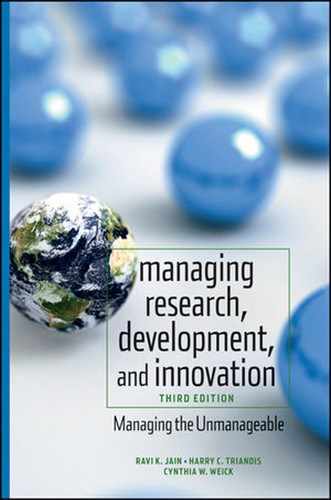Scott, S. G., and R. A. Bruce (1994). Determinants of innovative behavior: A path model of individual innovation in the workplace. Academy of Management Journal, 37, 580–607 (June).
Scott, W. B. (1994). NASA reshapes tech transfer. Aviation Week & Space Technology, 140(20), 55 (May).
Shanklin, W. L., and L. K. Ryans, Jr. (1984). Organizing for high-tech marketing, Harvard Business Review, 62(6), 164–171 (November–December).
Silberglitt, R., P. S. Antón, D. R. Howell, and A. Wong. (2006). The global technology revolution 2020, executive summary. Santa Monica, CA: RAND Corporation.
Smith, G. C. (1970). Consultation and decision processes in an R&D laboratory. Administrative Science Quarterly, 15, 203–215.
Smith, H. W. and Nomi, T. (2000). Is Amae the key to understanding Japanese Culture? Electronic Journal of Sociology, ISSN: 1198 3655 (April).
Snyder, M. (1979). Self-monitoring process. In L. Berkowitz (Ed.), Advances in Experimental Social Psychology, 12, 86–131. New York: Academic Press.
Sobre-Denton, M., and D. Hart (2008). Mind the gap: Application-based analysis of cultural adjustment models. International Journal of Intercultural Relations, In Press, Corrected Proof. (July).
Solow, R. M. (1957). Technical Change and the Aggregate Production Function. The Review of Economics and Statistics, 39(3), 312–320. MIT Press. (August 1957).
Souder, W. E. (1975). Stage-dominant (S-D), process-dominant (P-D) and task-dominant (T-D) models of the new product development (NOD) process: Some straw-men models and their contingencies. Technology Management Studies Group Paper (November 1).
Souder, W. E., and A. K. Chakrabarti (1980). Managing the coordination of marketing and R&D in the innovation process. In B. V. Dean and J. L. Goldhar (Eds.), Management of Research and Innovation. TIMS Studies in the Management Sciences, 15, 135–150. New York: North-Holland.
Spector, P. E. (1982). Behavior in organizations as a function of employee's locus of control. Psychological Bulletin, 91, 482–497.
Sternberg, R. J., and J. E. Davidson (1996). The Nature of Insight, Cambridge, MA: MIT Press.
Sternberg, R. J., and T. I. Lubart (1995). Defying the Crowd: Cultivating Creativity in a Culture of Conformity. New York: Free Press.
Sternitzke, Bartkowski, Schwanbeck, and Schramm (2007). Patent and literature statistics: The case of optoelectronics. Journal World Patent Information, 29, 327–338.
Stone, D. L., L. Isenhour, and K. M. Lukaszewski (2008). A model of the influence of cultural values on job application intentions and behaviors. In D. L. Stone, and E. F. Stone-Romero (Eds.) The influence of culture on human resources management processes and practices, 25–51. New York: Psychology Press.
Studt, T. (2007). World's Best R&D Companies. R&D Magazine, 13 (October).
Sullivan, W. (1983). 2 Americans Share Physics Nobel for Star Theories. The New York Times. October 20, 1983.
Sutton, C. (1986). Serendipity or sound science? New Scientist, 109, 30–32 (February).
Szakonyi (1994). Measuring R&D effectiveness-1. Research-Technology Management. 37(2), 27–32.
